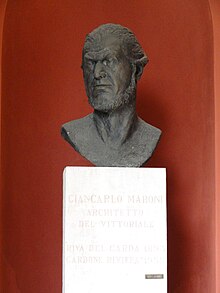Giancarlo Maroni
Giancarlo Maroni (* 1893 in Arco ; † 1952 in Riva del Garda ) was an Italian architect . He played a major role in the reconstruction and redesign of Riva del Garda after the First World War . The Vittoriale degli italiani in Gardone Riviera , the former residence of the poet Gabriele D'Annunzio (1863–1938), was created under his direction.
In 1993 the Museo Storico Rivas dedicated an exhibition to him entitled L'architetto del lago. Giancarlo Maroni e il Garda ("The architect of the lake. Giancarlo Maroni and Lake Garda").
Life
Maroni studied from 1910 to 1915 at the Scuola Speciale di Architettura dell ' Accademia di Belle Arti di Brera in Milan . His teachers included the architect Gaetano Moretti and the painter Alcide Davide Campestrini.
In May 1915 he volunteered for the Italian mountain troop , the Alpini . After being seriously wounded, he could no longer actively take part in combat operations and was deployed behind the front until the end of the war.
In 1919 Maroni went to Riva del Garda, just a few kilometers from his birthplace Arco. Together with his brother, the engineer Ruggero Maroni, he took on public and private contracts to repair war damage. Until 1924, both worked for the Commissione Edilizia del Comune di Riva , the building authority, and from 1920 to 1924 Giancarlo Maroni was, together with Luigi Pizzini, a member of the Commissione per il Piano Regolatore, which was responsible for the building plan and urban development .
In 1921 Gabriele D'Annunzio commissioned him to renovate the former villa of the art historian Henry Thode in Cargnacco, a district of Gardone Riviera . This marked the beginning of an intensive collaboration that lasted until the poet's death in 1938 and which resulted in the Vittoriale degli italiani. In addition to the role of architect, Maroni also increasingly took on the role of secretary and administrator. During this period he made trips to Florence , Bologna , Venice and Pompeii to procure objects for furnishing the Vittoriale and to conduct studies for its further expansion. He was in close contact with artists and artisans such as Guido Cadorin, Pietro Marussig , Renato Brozzi, Giacinto Bardetti, Napoleone Martinuzzi and Pietro Chiesa.
After D'Annunzio's death, Maroni was a member of the Consiglio della Fondazione del Vittoriale and continued to work as a curator for the Vittoriale.
Maroni died in 1952 and was buried in one of the arches of the mausoleum in the Vittoriale.
Places of work
Riva del Garda
After the end of the war, Maroni initially took on tasks in the area of reconstruction. This included public institutions such as the Palazzo dei Provveditori , the Canonica Arcipretale , the Chapel of San Rocco and the Piazzetta San Rocco , as well as private buildings such as the Casa Bettinazzi , Zaniboni , Armani and Marzani-Parteli .
Later, as a member of the Commissione per il Piano Regolatore in the historical part of the city , he dealt with the widening of existing and the creation of new streets and alleys. At the same time, he planned the expansion of the city along the lake shore to the east, with the aim of emphasizing the Mediterranean character: Examples are the Spiaggia degli Olivi , the Campo Sportive , the Giardina di infanzia and the reconstruction of the Hotel Sole d'Oro .
Gardone Riviera
Focus of activity Maroni is today nine hectares comprehensive Vittoriale degli Italiani , which arose mainly from 1921 to 1938 under his direction and was declared in 1925 a national monument. This includes the conversion and expansion of a villa to today's Prioria , the design of the parks, gardens and squares as well as the integration of the cruiser Puglia and the torpedo boat MAS . From 1931 to 1938 the plans for the open-air theater La Parlaggio were drawn up , which was completed in 1953.
In 1933 he took over work outside the Vittoriale in order to “bring the poet's residence into harmony with its surroundings”, for example the redesign of the Piazza dei caduti (“Place of the Fallen”).
One year after D'Annunzio's death, Maroni designed a mausoleum in 1939, which was built in 1955 on a hill on the Vittoriale.
Pescara
After the restoration of Gabriele D'Annunzio's birthplace in Pescara , which was started in 1926 by Antonino Liberi (1855–1933) and which was declared a national monument in 1927, stalled, Maroni was commissioned to continue the project. Work resumed in 1934 and completed in early 1938. During World War II it was heavily damaged, but is open to the new renovations since 1949 again for visitors.
Web links
- L'architetto del lago. Biografia di Giancarlo Maroni ( Memento of November 21, 2008 in the Internet Archive ) (Italian)
- Biography on the website of the Casa natale di Garbriele D'Annunzio (Italian)
Individual evidence
- ↑ a b c L'architetto del lago. Biografia di Giancarlo Maroni ( Memento of November 21, 2008 in the Internet Archive ). Retrieved March 15, 2017. (Italian)
- ^ A b Casa natale di Gabriele D'Annunzio - Giancarlo Maroni (1893–1952) . Retrieved March 15, 2017. (Italian)
- ↑ a b Il Vittoriale degli italiani . Retrieved August 8, 2009 (German, Italian, English)
- ^ Casa natale di Gabriele D'Annunzio - La storia . Retrieved March 15, 2017. (Italian)
photos
| personal data | |
|---|---|
| SURNAME | Maroni, Giancarlo |
| ALTERNATIVE NAMES | Maroni, Gian Carlo |
| BRIEF DESCRIPTION | Italian architect |
| DATE OF BIRTH | 1893 |
| PLACE OF BIRTH | Arco |
| DATE OF DEATH | 1952 |
| Place of death | Riva del Garda |







